Peking University
Peking University[note 1] (abbrev. PKU; colloquially known as Beida), is a major research university in Beijing, China, and a member of the elite C9 League of Chinese universities.[6] It is perennially ranked as one of the top academic institutions in China, Asia, and worldwide.[7][8]
北京大学 | |
 | |
Former names | Imperial University of Peking[1] |
|---|---|
Motto in English | Ensuring quality and pursuing excellence[2] |
| Type | Public |
| Established | 1898 |
| President | Hao Ping |
| Party Secretary | Qiu Shuiping |
Academic staff | 7,317[3] |
| Students | 39,575[4] |
| Undergraduates | 15,628[3] |
| Postgraduates | 27,027[3] |
| Location | , China 39°59′23″N 116°18′19″E |
| Campus | Urban, 274 ha (680 acres)[5] |
| Colours | Red |
| Affiliations | IARU, AALAU, AEARU, APRU, BESETOHA, C9, McDonnell International Scholars Academy |
| Website | www |
 | |
| Peking University | |||||||||||
|---|---|---|---|---|---|---|---|---|---|---|---|
| Simplified Chinese | 北京大学 | ||||||||||
| Traditional Chinese | 北京大學 | ||||||||||
| |||||||||||
The first modern national university established in China, it was founded during the late Qing Dynasty in 1898 as the Imperial University of Peking and was the successor of the Guozijian, or Imperial College.[9] The university's romanized name, Peking, retains the older transliteration of "Beijing" that has been superseded in most other contexts.[10]
Throughout its history, Peking University has had an important role "at the center of major intellectual movements" in China.[11] From the early 1920s, the university became a center for China's emerging progressive movements. Faculty and students held important roles in originating the New Culture Movement, the May Fourth Movement protests, and other significant cultural and sociopolitical events, to the extent that the university's history has been closely tied to that of modern China. Peking University has educated and hosted many prominent modern Chinese figures, including Mao Zedong, Lu Xun, Gu Hongming, Hu Shih, Mao Dun, Li Dazhao, Chen Duxiu, and the current Premier Li Keqiang.[12]
It hosts one of the only undergraduate liberal arts colleges in Asia. It is a Class A institution under the national Double First Class University program.[13]
Peking University's faculty includes 76 members of the Chinese Academy of Sciences, 19 members of the Chinese Academy of Engineering, and 25 members of the World Academy of Sciences.[3] Peking University Library is one of the largest libraries in the world with over 8 million volumes.[14] The university also operates the PKU Hall, a professional performing arts centers, and the Arthur M. Sackler Museum of Arts and Archaeology. Peking University is especially renowned for its campus grounds and the beauty of its traditional Chinese architecture.[15][16][17][18]
History
Establishment
From its establishment on July 3, 1898, the school was known as the Imperial University of Peking (simplified Chinese: 京师大学堂; traditional Chinese: 京師大學堂; pinyin: Jīngshī Dàxuétáng; lit.: 'Capital Grand Study Hall'). The school was established to replace the Taixue, specifically the Guozijian, or Imperial College, as part of the Hundred Days' Reform initiated by the Guangxu Emperor. Liang Qichao drafted the University's organising regulations. The university was authorised to administrate and supervise all provincial schools. Sun Jianai, who then served as the minister of the Ministry of Personnel under the Qing court, was appointed to manage the university. Recommended by Li Hongzhang, Emperor Guangxu appointed American missionary William Alexander Parson Martin to serve as the dean of Department of Western Learning.

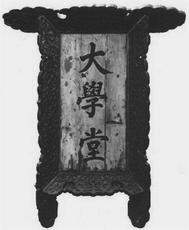
The Guangxu Emperor's reform initiatives were intensely opposed by powerful conservatives of the Qing court. On Sep 21,1898, Empress Dowager Cixi, with support from conservatives, abruptly ended the Hundred Days' Reform and put Guangxu under house arrest at Zhongnanhai. Cixi's coup d'état was followed by immediate rescinding of all policies and laws enacted by Guangxu and his reform-minded supporters, the Imperial University of Peking was the only part of the reform that survived.
In 1900, the university was paralyzed by the Boxer Rebellion, later in the year, the "Eight-Power Allied Forces" (八国联军) entered Beijing and the university's operating was continually suspended. In 1902, "Jingshitongwenguan", a school established by the Qing court in 1862 for foreign language learning was incorporated into the Imperial University of Peking. In 1904, the university sent 47 students to study abroad, which marked the first time for Chinese higher education institution to send students to foreign countries.
Following the Xinhai Revolution, the Imperial University of Peking was renamed "Government University of Peking" in 1912 and then "National University of Peking" in 1919[19] (simplified Chinese: 国立北京大学; traditional Chinese: 國立北京大學; pinyin: Guólì Běijīng Dàxué).
Early Republic of China period (1916–1927)
The noted scholar Cai Yuanpei was appointed president on January 4, 1917, and helped transform Peking University into the country's largest institution of higher learning, with 14 departments and an enrollment of more than 2,000 students. President Cai, inspired by the German model of academic freedom, introduced faculty governance and democratic management to the university. Cai recruited an intellectually diverse faculty that included some of the most prominent figures in the progressive New Culture Movement, including Hu Shih, Liu Banlong, Ma Yinchu, Li Dazhao, Chen Duxiu, Lu Xun and Liang Shuming. Meanwhile, leading conservatives Gu Hongming and Huang Kan also taught at the university.[20] A firm supporter for freedom of thought, Cai advocated for educational independence and resigned several times protesting the government's policy and interference.
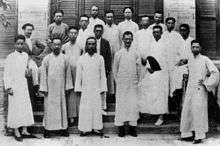
.jpg)
On May 1, 1919, some students of Peking University learned that the Treaty of Versailles would allow Japan to receive Germany's colonising rights in Shandong province. An assembly at Peking University that included these students and representatives from other universities in Beijing was quickly organised. On May 4, students from thirteen universities marched to Tiananmen to protest the terms of Treaty of Versailles, demanded the Beiyang government to refuse to sign the treaty. Demonstrators also demanded the immediate resignation of three officials: Cao Rulin, Minister of the Ministry of Transportation, Zhang Zongxiang, China's Ambassador to Japan and Lu Zongyu, Minister of Currency, who they believed were in cooperation with Japanese. The protest ended up with some protesters being beaten and arrested, and Cao Rulin's house burned by protesters. Following the protest on May 4, students, workers and merchants from nearly all China's major cities went on strike and boycotted Japanese goods in China. The Beiyang government eventually agreed to release the arrested students and fired the three officials under intense public pressure, China's representatives in Paris refused to sign the Treaty of Versailles.[21]
These protests, now known as the May Fourth Movement, has been widely regarded as one of the most important turning points in modern China's history. In its broader sense, the May Fourth Movement led to the establishment of radical Chinese intellectuals who went on to mobilize peasants and workers into the Communist party and gain the organizational strength that would solidify the success of the Communist Revolution.
Following the May Fourth Movement, Li Dazhao, who was then the director of Peking University Library and also a professor of economics, founded the first communist organisation in Beijing while Chen Duxiu founded another communist organisation in Shanghai.
In 1920, Peking University became the first Chinese university to accept female students.
World War II (1927–1949)
After the outbreak of the Second Sino-Japanese War in 1937 and the resulting expansion of Japanese territorial control in east China, Peking University was relocated to the southwestern city of Changsha and formed the Changsha Temporary University along with nearby schools Tsinghua University and Nankai University. In 1938, the three schools moved again, this time further southwest to Kunming, and formed the National Southwestern Associated University.
In 1946, after the Japanese surrender in World War II, Peking University moved back to Beijing. At that time, the university comprised six schools (Arts, Science, Law, Medicine, Engineering, and Agriculture), and a research institute for humanities. The total student enrollment grew up to 3,000.
People's Republic of China (1949–present)
In 1949, after the People's Republic of China was established, Peking University lost its "national" appellation to reflect the fact that all universities under the new socialist state would be public. In 1952, Mao Zedong's government re-grouped the country's higher education institutions with individual institutions tending to specialize in a certain field of study after the Soviet model. As a result, some arts and science faculties of Tsinghua University and former Yenching University were merged into Peking University. At the same time, however, the university lost its Law, Medicine, Engineering and Agriculture schools. These schools and faculties were either merged into other universities or to found new colleges. During the re-grouping, Yenching University was closed up. Peking University moved from downtown Beijing to the former Yenching campus.

The first disturbances of the Cultural Revolution began at Peking University in 1966; education there ceased between 1966 and 1970.
On May 4, 1998, at the 100th anniversary of Peking University, Communist Party General Secretary Jiang Zemin announced that the government would initiate a national project to promote China's higher education by funding selected universities to achieve world-class level. The project was later named “985” based the date of its announcement.
In 2000, Beijing Medical University was merged back into Peking University and became the Peking University Health Science Campus. Beijing Medical University used to be Medical School of Peking University and was separated from Peking University at 1952. Peking University now has eight affiliated hospitals and 12 teaching hospitals.
In 2001, Peking University established the Yuanpei Program. It was formalized in 2007 as the Yuanpei College, named in honor of the highly respected former university president Cai Yuanpei. The college hosts an elite undergraduate liberal arts program that allows students to freely choose specialisations. In the same year, Peking University set up a satellite campus for graduate students in Shenzhen. The university's second business school, Peking University HSBC Business School was launched on the Shenzhen campus in 2004.
In 2014, Peking University established the Yenching Academy, a fully funded global fellowship program designed "to cultivate leaders who will advocate for global progress and cultural understanding."
In 2018, Peking University was subject to criticism over its handling of sexual assault allegations against a member of the faculty, Professor Shang Yang. The accuser, Gao Yan, a Chinese literature undergraduate, accused the teacher of rape; she committed suicide in 1998.[22] On April 9, 2018, student activist Yue Xin filed a freedom of information request to the university for documents related to the accusations, specifically Professor Yang's official self-criticism documents. According to Yue, the university faculty attempted on numerous occasions to coerce her into rescinding the request.[23] The incident has been referred to as being part of the international Me Too movement.[22] Following The Jasic Incident of 2018, Peking University began exerting pressure on its student-led Marxist group, The Peking University Marxist Society. During the autumn semester of 2018, The Marxist Society was informed that it would not be able to re-register as an academic club.[24][25] The group released a statement in September announcing that it would likely be shut down by the university in the near future.[26] Peking University undergraduate student and head of the Marxist Society Qiu Zhanxuan was arrested by Chinese police on December 28, while traveling off campus to a celebration of Mao Zedong's 125th birthday.[27][28]
Campus

The campus of Peking University was originally located northeast of the Forbidden City in the center of Beijing, and was later moved to the former campus of Yenching University in 1952. The main campus is in northwest Beijing, in Haidian district, near the Summer Palace and the Old Summer Palace; the area is traditionally where many of Beijing's most renowned gardens and palaces were built.
The university campus is in the former site of the Qing Dynasty imperial gardens and it retains much traditional Chinese-style landscaping, including traditional houses, gardens, pagodas, as well as many notable historical buildings and structures. The landscape in campus gives a presentation of combined western styles with traditional Chinese aesthetic standards. American architect and art historian Talbot Hamlin designed some of the university's buildings constructed during the 1919 to 1922 period.[29] There are several gates that lead into campus — East, West and South gates, with the West Gate being the most well known for the painted murals on its ceiling. Weiming lake is in the north of the campus and is surrounded by walking paths and small gardens. The university hosts many museums, such as the Museum of University History and the Arthur M. Sackler Museum of Art and Archaeology.[30][31] Notable items in these museums include funerary objects that were excavated in Beijing and date back thousands of years from the graves of royalties of the Warring States period. There are ritual pottery vessels as well as elaborate pieces of jewelry on display. There are also human bones set up in the traditional burial style of that period.[31]
Beyond its main campus, Peking University Health Science Center (PKUHSC) is on Xueyuan Road where the country's most distinguished colleges are. The PKUHSC's campus is less aesthetically appealing than the main Peking University campus but is nonetheless a fitting site for academics and research.
In 2001, Peking University's Shenzhen campus, the Shenzhen Graduate School, opened its doors. The campus is located in the northwest part of Shenzhen City.
 Peking University during winter. The campus is situated on a former imperial garden.
Peking University during winter. The campus is situated on a former imperial garden.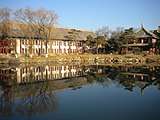 The College of Architecture and Landscape
The College of Architecture and Landscape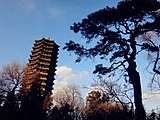 Boya Pagoda by Weiming lake
Boya Pagoda by Weiming lake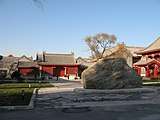 The Humanities Buildings
The Humanities Buildings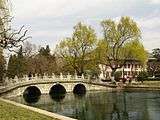 A stone bridge inside the campus
A stone bridge inside the campus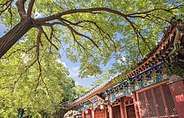 Peking University West Gate
Peking University West Gate- Arthur M. Sackler Museum of Arts and Archaeology
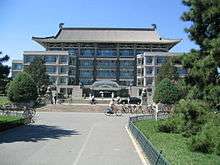 Peking University's Main Library
Peking University's Main Library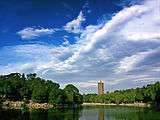 Weiming Lake occupies the central part of the campus of Peking University
Weiming Lake occupies the central part of the campus of Peking University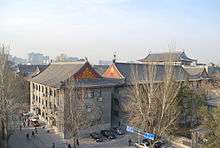 Office buildings
Office buildings The Life Sciences Building
The Life Sciences Building Peking University's Science Teaching Building
Peking University's Science Teaching Building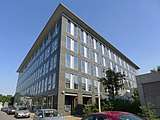 School of International Studies
School of International Studies
Academics
| University rankings | |
|---|---|
| Global – Overall | |
| ARWU World[32] | 49 |
| THE World[33] | 24 |
| QS World[34] | 22 |
| Regional – Overall | |
| THE Asia[35] | 2 |
| QS Asia[36] | 4 |
| QS BRICS[37] | 2 |
| National – Overall | |
| BCUR National[38] | 2 |
Peking University consists of 30 colleges and 12 departments, with 93 specialties for undergraduates, 2 specialties for the second Bachelor's degree, 199 specialties for Master's degree candidates and 173 specialties for doctoral candidates. In addition to basic research, the university also conducts applied research.
At present, Peking university has 216 research institutions and research centres, including 2 national engineering research centers, 81 key national disciplines, 12 national key laboratories. With 11 million holdings, the university library is the largest of its kind in Asia.[39]
Peking University, the Georgia Institute of Technology, and Emory University jointly administer the Wallace H. Coulter Department of Biomedical Engineering.[40][41] Peking University has been becoming a center for teaching and research, consisting of diverse branches of learning such as pure and applied sciences, social sciences and humanities, and sciences of management and education.
Over the past century, some Peking University alumni had become presidents of other major Chinese universities, including former Tsinghua President Luo Jialun, Renmin University President Yuan Baohua, Zhejiang University President Qian Sanqiang, Fudan University President Zhang Zhirang, Nankai University President Teng Weizao, Chinese University of Science and Technology President Guan Weiyan and many others.[42]
Many domestic rankings have placed Peking University among the top universities in mainland China.[43] In 2015, the Chinese University Alumni Association[44] in partnership with China Education Center considered it 1st among all Chinese universities.[43]
U.S. News & World Report ranked Peking University 41st in the world, 1st in Greater China, and 2nd in Asia.[45] It also topped the newly launched Times Higher Education BRICS & Emerging Economies.[46] In 2019, it ranked 15th among the universities around the world by SCImago Institutions Rankings.[47]
Schools and Institutes
| Division of Sciences | |||
| School of Mathematical Sciences | School of Physics | College of Chemistry and Molecular Engineering | School of Life Sciences |
| College of Urban and Environmental Sciences | School of Earth and Space Sciences | School of Psychological and Cognitive Sciences | College of Architecture and Landscape Architecture |
| Division of Information and Engineering | |||
| School of Electronics Engineering and Computer Science | College of Engineering | Institute of Computer Science and Technology | School of Software and Microelectronics |
| College of Environmental Sciences and Engineering | National Engineering Research Center for Software Engineering* | ||
| Division of Humanities | |||
| Department of Chinese Language and Literature* | Department of History | School of Archaeology and Museology | Department of Philosophy, and of Religious Studies |
| School of Foreign Languages | School of Arts | School of Chinese as a Second Language | Academy of Opera |
| Division of Social Sciences | |||
| School of International Studies | Law School | Department of Information Management | Department of Sociology |
| School of Government | School of Marxism | Graduate School of Education | School of Journalism and Communication |
| Department of PE | School of New Media* | ||
| Division of Economics and Management | |||
| School of Economics | Guanghua School of Management | Institute of Population Research | National School of Development |
| Peking University Health Science Center | |||
| School of Basic Medical Sciences | School of Pharmaceutical Sciences | School of Public Health | School of Nursing |
| Institute of Medical Humanities/School of Foundational Education Health Science Center | School of Continuing Medical Education* | Peking University First Hospital | Peking University People's Hospital |
| Peking University Third Hospital | Peking University Hospital of Stomatology | Peking University Sixth Hospital | Peking University Cancer Hospital |
| Peking University Shenzhen Hospital | Peking University Shougang Hospital | ||
| Interdisciplinary | |||
| Yuanpei College (undergraduate liberal arts) | Yenching Academy | Advanced Technology Institute | Academy for Advanced Interdisciplinary Studies |
| Institute of Social Science Survey | Institute of Molecular Medicine | The Kavli Institute for Astronomy and Astrophysics | Institute of Nuclear Sciences and Technology |
| Beijing International Center for Mathematical Research | Institute of Ocean Research* | School of Advanced Agricultural Sciences | Institute of Humanities and Social Sciences |
| Shenzhen Graduate School | |||
| School of Electronic and Computer Engineering | School of Chemical Biology and Biotechnology | School of Environment and Energy* | School of Urban Planning and Design |
| School of Advanced Materials | HSBC Business School | School of Transnational Law | School of Humanities and Social Sciences |
Culture
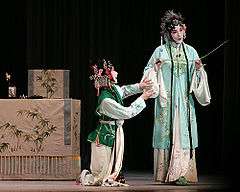
Peking University is well known for its contribution to modern Chinese literature, poetry and art, and for the publications of groundbreaking modern Chinese books such as Hong Zicheng's A History of Contemporary Chinese Literature.[48]
Peking University has participated in many joint art-research projects, such as the Center for the Art of East Asia (CAEA) with the University of Chicago,[49] and Department of Digital Art and Design with UNESCO.[50][51]
Peking University partners with Stanford University for its Asian cultural studies programs such as the Stanford Program in Beijing and the Stanford-Peking University Summer Program, which encourages Stanford students interested in exploring Chinese language, history, culture, and society to study on campus at Peking University.[52]
National School of Development (NSD)
The National School of Development (formerly China Center for Economic Research) is ranked amongst the top five most influential think tanks in China.[53]
In 1998, Justin Yifu Lin et al. jointly founded the Beijing International MBA at Peking University (BiMBA),[54] which is ranked among the top six MBA programs by Quacquarelli Symonds in its TopMBA ranking of the best MBA programs in Asia Pacific for the year 2014–2015.[55] BiMBA has also been ranked as the second most valuable full-time MBA in China by Forbes (after CEIBS)[56] and among Asia's best business schools by Bloomberg Business.[57][58]
Peking University Shenzhen Graduate School
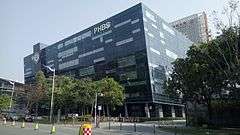
Peking University Shenzhen Graduate School is a satellite campus of Peking University located in Shenzhen, Guangdong. It was founded in September, 2001 in collaboration with the Shenzhen Municipal Government and is located in University Town of Shenzhen along with satellite campuses of Tsinghua University and Harbin Institute of Technology. Dr. Wen Hai, a renowned economist in China and the vice-president of Peking University is the present chancellor of PKU Shenzhen.[59] The school houses seven research departments as well as the Peking University HSBC Business School and Peking University School of Transnational Law.[60]
On August 29, 2016, Peking University signed a strategic agreement with the Shenzhen Municipal Government to further develop its Shenzhen Graduate School, the university plans build a brand new campus near the existed graduate school and open undergraduate programs.[61]
International students
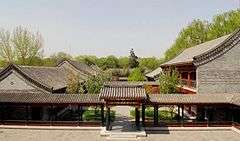
The dormitories for international students at the main campus are located at Shao Yuan (勺园) and Zhongguan Xinyuan (中关新园). Every year, Peking University has approximately 2,000 international students studying on the Beijing campus and about 50 at the Peking University HSBC Business School, located at the Shenzhen Campus. Its international students are made up of students from most countries in the world including most of Western Europe, North America, and South America; all parts of Asia; Australia; and many countries in Africa.
In 2005, Peking University and Cornell University signed an agreement formally establishing[62][63] the China and Asia-Pacific Studies major[64] at Cornell, which requires students to spend a semester studying at Peking University while working at internships. One year later, Peking University launched a joint undergraduate program with Yale University;[65][66] students will spend a semester overseas, living and studying together with the host institute's students.[66] Peking University's School of International Studies also launched joint degree programs with London School of Economics, Paris School of International Affairs,[67] Waseda University, Seoul National University, and the University of Tokyo. Peking also has a longstanding relationship with Stanford University which operates a joint research center and base for Stanford students and scholars at the Stanford Center at Peking University, located in the Lee Jung Sen Building.[68] The Peking University HSBC Business School has joint degree programs with University of Hong Kong and Chinese University of Hong Kong.
The university has maintained a partnership with the Freie Universität Berlin since 1981 and the Higher School of Economics since 2015.
Peking University recently became a partner of Washington University of St. Louis through the McDonnell International Scholars Academy.[69][70]
Notable alumni
Politics
According to CUAA's 2015 ranking of notable alumni in politics, Peking University has produced the most notable politicians among all universities in China.[71] As of 2017, 88 Peking University alumni currently serve in the government at vice-ministerial positions or higher,[72] two of the seven member Standing Committee of the CPC, Li Keqiang and Zhao Leji, are Peking University alumni. Bo Xilai, former member of the Politburo and Communist Party Secretary of Chongqing, who was convicted on corruption charges in 2013 and sentenced to life in prison, also graduated from Peking University.
.jpg) Incumbent Premier of China, Li Keqiang.
Incumbent Premier of China, Li Keqiang. Ex-member of the Politburo and Communist Party Secretary of Chongqing, Bo Xilai.
Ex-member of the Politburo and Communist Party Secretary of Chongqing, Bo Xilai.
Philosophy and Literature
 Lu Xun, leading figure of modern Chinese literature.
Lu Xun, leading figure of modern Chinese literature.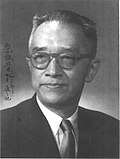 Hu Shih, influential Chinese philosopher and essayist.
Hu Shih, influential Chinese philosopher and essayist.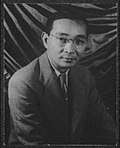 Lin Yutang, Chinese writer, linguist, inventor and translator.
Lin Yutang, Chinese writer, linguist, inventor and translator.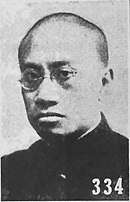 Liang Shuming, philosopher.
Liang Shuming, philosopher. Gu Hongming, translator and educator.
Gu Hongming, translator and educator.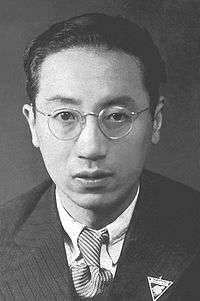 Fei Xiaotong, sociologist and anthropologist.
Fei Xiaotong, sociologist and anthropologist.
Science, Mathematics, and Medicine
- Deng Jiaxian 邓稼先 – a nuclear physics expert; a leading organizer and key contributor to the Chinese nuclear weapon programs.
- Qian Sanqiang 钱三强 – a nuclear physicist and education administrator; a leading organizer and key contributor to the Chinese nuclear weapon programs; former president of Zhejiang University
- Zhu Guangya 朱光亚 – a renowned nuclear physicist of China, key contributor to China's "Two Bombs, One Satellite" projects.
- Zhou Guangzhao 周光召 – expert on particle physics, discoverer of PCAC (partial conservation of axial current), an important step toward the understanding of symmetry breaking; former director of the Chinese Nuclear Weapons Research Institute and president of the Academica Sinica.
- Yitang Zhang 张益唐 – B.S. 1982, M.S. 1985, mathematician Discovered upper bond of prime numbers as close to 70, 000, 000, and won Ostrowski Prize (2013) Cole Prize (2014) Rolf Schock Prize (2014) MacArthur Fellowship (2014).
- Li Bulou 李步楼 – a translator and philosopher. Holds the honor of "Experts with outstanding contributions" given by the State Council of the People's Republic of China.
- Tu Youyou 屠呦呦 – a pharmaceutical chemist and educator. She is best known for discovering artemisinin (also known as qinghaosu) and dihydroartemisinin, used to treat malaria, which has saved millions of lives. For her work, Tu received the 2011 Lasker Award in clinical medicine and the 2015 Nobel Prize in Physiology or Medicine jointly with William C. Campbell and Satoshi Ōmura. Tu received The State Preeminent Science and Technology Award (2016)
- Yu Min 于敏 – a prominent Chinese nuclear physicist, father of China's H-bomb. Yu received The State Preeminent Science and Technology Award (2014).
- Wang Xuan 王选 – a computer scientist and innovator of the Chinese printing industry. Wang received The State Preeminent Science and Technology Award (2001).
- Wang Zhongcheng 王忠诚 – a neurosurgery expert, pioneer and one of the founders of neurosurgery in China. Wang received The State Preeminent Science and Technology Award (2008).
See also
- 7072 Beijingdaxue – asteroid named after Peking University
- Affiliated High School of Peking University
- Beijing International MBA
- Beijing Medical University
- China Family Panel Studies
- History of Beijing
- Beijing Guozijian
- Project IMUSE
Notes
- Also called Beijing University.
References
- "History Peking University". Peking University. Archived from the original on 2015-07-16. Retrieved 15 July 2015.
- "History: Peking University in the 21st Century". Peking University. Archived from the original on 3 October 2019. Retrieved 22 July 2019.
- 北京大学 2017 年基本数据 (PDF). Retrieved 2018-07-04.
- https://www.topuniversities.com/universities/peking-university
- "About PKU, General Information". Peking University. Retrieved 17 May 2018.
- "Best universities in China 2018". Times Higher Education. 6 September 2017.
- "QS World University Rankings 2020". Top Universities. 2019-06-05. Retrieved 2020-01-03.
- "QS World University Rankings". Top Universities. Retrieved 2020-01-03.
- Hao Ping (郝平) (1998). Beijing da xue chuang ban shi shi kao yuan (Di 1 ban ed.). Beijing: Beijing da xue chu ban she. ISBN 9787301036617. OCLC 40906464.
- Bagehot (November 11, 2010). "Beijing or Peking? And why are only the English nagged about this". The Economist.
- "Peking University". www.sunypress.edu. Retrieved 2018-12-29.
- Peking University - Mingren Archived 2008-08-04 at the Wayback Machine
- 教育部 财政部 国家发展改革委 关于公布世界一流大学和一流学科建设高校及建设 学科名单的通知 (Notice from the Ministry of Education and other national governmental departments announcing the list of double first class universities and disciplines).
- "The introduction of Peking university". Peking University Library.
- Francis Whittaker (July 14, 2011). "Most beautiful universities". MSN. Archived from the original on October 4, 2013. Retrieved October 4, 2013.
- Stirling Kelso (September 2012). "World's Most Beautiful Universities". Travel and Leisure.
- "15 Of The World's Most Beautiful Universities Revealed". The Huffington Post UK. July 11, 2013.
- "NUS PKU MBA - About Peking University - Overview". Archived from the original on 16 July 2015. Retrieved 15 July 2015.
- "[Anniversary Special] "In the beginning was the word"". Peking University. 2011-05-02. Archived from the original on 2017-11-13. Retrieved 2017-09-09.
- A companion to Asian art and architecture. Brown, Rebecca M., Hutton, Deborah S. Chichester, West Sussex, UK: Wiley-Blackwell. 2011. ISBN 9781444396355. OCLC 767516261.CS1 maint: others (link)
- "World Policy Journal - Summer 2005 - World Policy". World Policy. Archived from the original on 2018-07-01. Retrieved 2018-05-11.
- Hernández, James C.; Zhao, Iris. "Students Defiant as Chinese University Warns #MeToo Activist". New York Times. Retrieved 22 November 2018.
- Kuo, Lily (24 April 2018). "Student says Peking University trying to silence her over rape claim petition". the Guardian. Guardian. Retrieved 22 November 2018.
- Financial Times https://www.ft.com/content/ccab09aa-bdc2-11e8-8274-55b72926558f. Missing or empty
|title=(help) - Xiao, Eva; Yiu, Pak (2018-11-23). "Too Marxist for China? Radical students rattle Communist leaders". Hong Kong Free Press HKFP. Retrieved 2019-01-08.
- "Officials in Beijing worry about Marx-loving students". The Economist. 27 September 2018. Retrieved 8 January 2019.
- "Leading Chinese Marxist student taken away by police on Mao's birthday". Reuters. 2018-12-26. Retrieved 2019-01-08.
- 赫海威2019年1月2日 (2019-01-02). "Archived copy" 中国压制左派青年,北大学生举行抗议活动. 纽约时报中文网 (in Chinese). Archived from the original on 2019-01-04. Retrieved 2019-01-08.CS1 maint: archived copy as title (link)
- http://library.columbia.edu/locations/avery/da/collections/hamlin_tf.html
- Arthur M. Sackler Museum of Art & Archaeology Archived 2011-04-11 at the Wayback Machine
- "A destination to be explored". Retrieved 15 July 2015.
- "ARWU World University Rankings 2020 - Academic Ranking of World Universities 2020 - Top 1000 universities - Shanghai Ranking - 2020". www.shanghairanking.com. Retrieved 16 August 2020.
- "World University Rankings". 18 August 2017. Retrieved 16 May 2018.
- "QS World University Rankings 2019". 6 June 2018. Retrieved 7 June 2018.
- "Asia University Rankings". 14 March 2017. Retrieved 16 May 2018.
- "QS University Rankings: Asia 2019". 5 November 2015. Retrieved 16 May 2018.
- QS University Rankings 2018
- Best Chinese Universities Ranking, Overall Ranking - 2018
- Harvard News Office. "Harvard Gazette: Summers visits People's Republic of China". Retrieved 15 July 2015.
- "Georgia Tech / Emory / Peking University BME PhD Program".
- "Georgia Tech Partnership".
- Club Yahoo!
- www.chinaeducenter.com. "University in China. China Education Center". Chinaeducenter.com. Retrieved 2012-04-22.
- "2016 China University Ranking by Alumni Association". CUCAS.
- "USNews Top World University Ranking". USNews. Archived from the original on October 28, 2014. Retrieved October 10, 2014.
- "BRICS & Emerging Economies Rankings 2014". Times Higher Education. Retrieved October 2, 2014.
- "SCImago Institutions Rankings - Higher Education - All Regions and Countries - 2019 - Overall Rank". www.scimagoir.com.
- "A History of Contemporary Chinese Literature". Brill Publishers. Archived from the original on 2008-12-08. Retrieved 2008-10-12.
- "Center for the Art of East Asia". University of Chicago. Archived from the original on 2008-10-10.
- Culture: Peking University, Department of Digital Art and Design UNESCO.
- "Peking University, Department of Digital Art and Design". Archived from the original on 16 August 2008. Retrieved 15 July 2015.
- "Overseas Studies". Stanford University.
- "China Network– Peking University's National School of Development: The Brains behind China's growth". Archived from the original on 2015-07-03. Retrieved 15 July 2015.
- "National School of Development ranks in top five Think Tanks for Highest Professional Influence_Peking University". Archived from the original on 2015-07-03. Retrieved 15 July 2015.
- "The Top 10 Business Schools in Asia-Pacific 2014/15". TopMBA.com. Retrieved 15 July 2015.
- Russell Flannery & Chloe Chen (26 April 2010). "China's Best Business Schools". Forbes. Retrieved 15 July 2015.
- Frederik Balfour; Bruce Einhorn; Moon Ihlwan; Mehul Srivastava & Hiroko Tashiro. "Asia's Top Business Schools". Businessweek.com. Retrieved 15 July 2015.
- "Keeping the Bar High at BiMBA". Businessweek.com. Retrieved 15 July 2015.
- "Peking University Shenzhen Graduate School - Peking University Shenzhen Graduate School". Archived from the original on 4 June 2012. Retrieved 14 April 2016.
- "Schools - Peking University Shenzhen Graduate School". Archived from the original on 6 October 2012. Retrieved 14 April 2016.
- "北京大学将建深圳校区 拓展本科和医学教育". edu.sina.com.cn. Archived from the original on 2017-10-26. Retrieved 2017-10-26.
- "Rawlings heads to China to sign partnership agreement and deliver keynote address at economic summit in Beijing - Cornell Chronicle". Retrieved 15 July 2015.
- "Launching China and Asia-Pacific Studies, a 'revolutionary' new undergraduate major - Cornell Chronicle". www.news.cornell.edu. Retrieved 16 May 2018.
- "China and Asia-Pacific Studies". Retrieved 15 July 2015.
- "Peking University - Yale University Joint Undergraduate Program in Beijing - Yale College". Archived from the original on 30 July 2015. Retrieved 15 July 2015.
- English - People's Daily
- "Dual Degree - Peking University - Sciences Po PSIA". www.sciencespo.fr. 26 May 2014. Archived from the original on 14 May 2018. Retrieved 16 May 2018.
- "Stanford Center at Peking University".
- "Peking University". Global. Archived from the original on 2019-08-04. Retrieved 2019-08-04.
- "McDonnell International Scholars Academy". Global. Retrieved 2019-08-04.
- "Archived copy" 2015中国大学杰出政要校友排行榜 北大居首_教育_腾讯网. edu.qq.com (in Chinese). Archived from the original on 2017-10-29. Retrieved 2017-10-28.CS1 maint: archived copy as title (link)
- www.360doc.com. "88位现任省部级以上北大校友丨最新名录". www.360doc.com. Archived from the original on 2017-10-29. Retrieved 2017-10-28.
Further reading
- Lin, Xiaoqing Diana (2005). Peking University: Chinese Scholarship and Intellectuals, 1898-1937. State University of New York Press. ISBN 978-0-7914-8391-6.